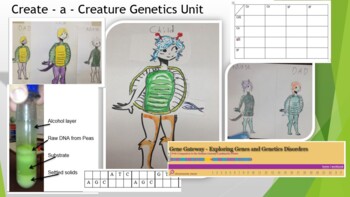Create - a - Creature Genetics Unit
- PDF
- Easel Activity
- Easel Assessment
Also included in
- Are you looking for a bundle of affordable STEM labs for your science class? This bundle has 38 files worth of field tested labs. All include materials list, worksheets, and field pictures! You can cover earth science, chemistry, biology as well as other topics with this package. The bundles coverPrice $85.82Original Price $153.25Save $67.43
- This master bundle combines genetic labs from across the full 3D-PT store! This bundle is easily a 1 semester genetics unit! Cover DNA / RNA, genotype / phenotype, evolution, and other biology topics!You can 3D print DNA & RNA, Create a creature, loose a shoe, or have other fun in the biology laPrice $24.12Original Price $33.50Save $9.38
Description
This whole unit covers the basics of genetics! It includes the Create a Creature lab, home genetic test, Punnet Squares, webquest, and final test!
You can also extract DNA from dried peas; practice reading DNA and RNA; explore genetic disorders through the Human Genome Project webquest; and explore pedigree charts!
You will have to create your own shell and tail pieces this. The original artist has gone on to draw a Google doodle ! You can also have the students design their own shell / tails.
This whole unit covers a general science class needs for Genetics. The DNA extraction lab is easy to follow and used in classrooms around the world. For extra credit you can play the Chet Akins song "I'm my own Grandpa" and try to figure out the family tree.
There is a part of this lab where I talk about ansomia (poor or no sense of smell) when I did this in class I demonstrated this by sticking my nose into a jar of chopped garlic. For me personally I can barley smell it, but I know the rest of the room smelled like a kitchen that day. If you can find an alternative video that would work better. 3D-PT is not liable for students who try to smell something wrong and putting it on TikTok.
Key Words: DNA, RNA, genetics, monogenetic, Punnet squares, inheritance, traits, genome, human genome project, ATCG, monohybrid cross, dihybrid cross, phenotype, genotype, pedigree chart, genetic disorders, create a creature, familial traits, home testing, monogenetic traits, Chet Akins, I'm my own grandpa.








